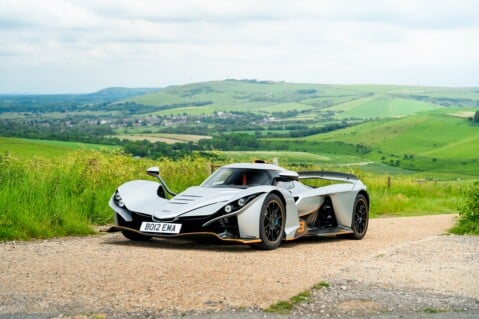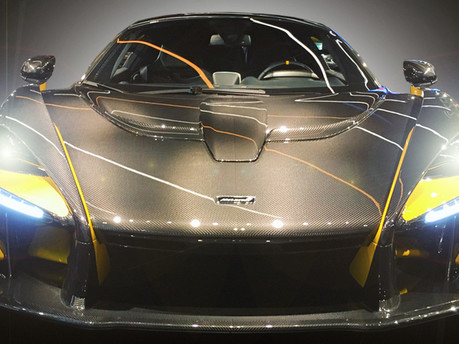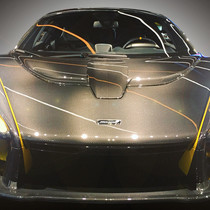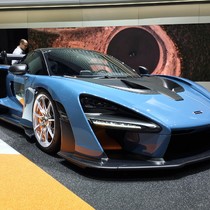
Geneva Motor Show Highlights: McLaren Senna
Last month the Premier GT team made their way out to Geneva to witness the 88th Geneva Motor Show first hand. Taking place at Geneva's Palexpo exhibition hall, for 13 days every March the automotive world’s gaze is cast on the venue. This year was a particular highlight in the motor show's history with 180 exhibitors in attendance, no less than 110 World and European premiers displayed and a total of over 900 models exhibited.
In this post we take an in-depth look back at one of the stars of the show, McLaren’s stunning, Senna. A car which we are sure will a become highly sought after machine into the future.
The McLaren Senna
It’s hard to believe just how young McLaren Automotive is. In just the eight years after the companies original inception back in 2010, McLaren has delivered and continues to offer a range of road cars with a pedigree even the established players in their sector would be envious of.
In that time we have seen the likes of the 12C, 675, 720S and the mighty McLaren P1 come to the fore with much critical acclaim. With the P1 establishing itself as one of the fabled ‘holy trinity’ of hypercars, the marques latest powerhouse has a high benchmark to exceed.
With prices starting at £750,000, let’s start then by addressing the undeniable, this thing looks absolutely mind-blowing. Released to the world back in November the Senna received mixed reviews from both the motoring press and general public alike, however whatever your take on its looks, there is no denying that this thing has real presence and has clearly been designed with function first with form following behind.
What you have, built around its carbon fibre monocoque is a body that has been designed to extract the absolute maximum in aerodynamic performance. Starting at the front of the car is an enormous, all carbon fibre splitter to cut into the airflow.
Working in conjunction with this splitter is a raft of active aerodynamic winglets within the front bumper which open and close dependent on speed and which act to reduce drag and make the airflow work harder to increase downforce when closed. These winglets are also designed to direct airflow around the sides of the car and into the mighty engine air intakes which sit just before the rear wheel arches, before being discarded over the Senna’s rear wing.
For all it’s aerodynamic trickery at the front of the car, its the rear that is the Senna’s standout feature, which displays an aggressive carbon fibre diffuser and upward facing tri exhaust outlet. Given McLaren’s Formula One know how it appears that there has been some carryover here in that regard with this exhaust configuration appearing to blow the underside element of the cars rear wing. Something that has been utilised to great effect in Formula One, it appears that the technical minds at McLaren have been able to transfer this to the road in an effort to extract even more downforce. The rear wing itself is also another toy in the box of the active aero tricks, by lowering its profile at high speed and cutting up aggressively under braking to slow the car.
All this aerodynamic trickery is more than just a vanity project. McLaren claims that the Senna is capable of delivering up to 800 kgs of downforce, and it needs it too. Nestled to the rear of its carbon fibre cocoon, the McLaren Senna features a 4.0-Litre twin turbo V8 engine which is capable of producing a power output of 789 bhp, a standstill to 62 mph time of 2.8 seconds and onwards to a top speed of 211 mph. Consider that the Senna weighs in at 1,198 kg and you have a road car with a power-to-weight ratio of 658 bhp per tonne.
MSO Carbon Theme & Senna GTR
Also on display at Geneva were the Senna GTR and a McLaren Special Operations fettled Senna which features the divisions ‘Carbon Theme’.
Offered only to buyers of the road going Senna, the track-only variant is even more hardcore. Limited to just 75 examples worldwide the GTR features an extra 25 bhp and an even more capable aerodynamic package. Featuring an enlarged front splitter and gigantic rear diffuser, the GTR is reported to be capable of generating over a tonne of downforce, a full 200kg more than it’s road-going counterpart. Prices for the GTR start at a cool, £1 million apiece.
Completing the McLaren Senna roster at Geneva was the MSO Carbon Theme. With this special customisation package costing an additional £300,000, it features a highly polished carbon body with yellow flashes across the bodywork and winglets. Contrasting the bodywork are the green brake callipers and the subtle blue and red wheel nuts. These colours all used in a nod to Ayrton Senna’s Brazilian nationality.
Muted by McLaren to be second only to a Formula One car around a race track, it’s going to be very interesting indeed to see how close this claim is to reality. We won’t have to wait long to find out either, as all 500 allocated slots of the road car and the 75 GTR examples have all been already sold.
Whatever way you look at it, the McLaren Senna is a fitting tribute to the late, great Ayrton Senna.



